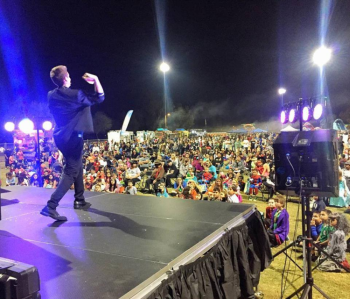
It can be difficult to visualize and choose just what size the stage should be for your next event, particularly when there is a diverse mixture of people and performers who will be using it.
Determining the correct area of a stage is sometimes more art than science. Unfortunately, event planners and managers at times do not give it enough consideration. The horizontal area must accommodate any and all activities that will take place on it. Even though speeches may occupy 3 hours and 55 minutes out of a 4-hour program with only one speaker appearing at a time, but there is a finale with a 12-member dance ensemble, the stage has to be big enough from the outset to accommodate the dance ensemble. In other words, it must be large enough to allow for the activity that will require the most space, no matter how important or how long that activity is in relation to the rest of the staged program.
For most activities, there are no golden rules. Every performing group usually has a minimum size of stage that will accommodate their performance and they should be consulted prior to event setup to ensure that the properly sized stage is ordered. Generally, for speakers at a lectern, a minimum of 15 - 20 ft² is required. Unfortunately, if the event consists of only speeches by one or two persons at a time such as an awards ceremony, having a small stage might not automatically be the correct choice. The stage size in relation to the size of the venue and also in relation to the size of the stage set and any additional décor or audio-visual equipment must be taken into consideration. For example, if an awards ceremony is to take place with a stage set up in the middle of a 150 ft long wall, and two large A-V screens with surrounding drape are to extend to the side walls on either side of the stage, it does not make good design sense to have a stage that is only eight or 12 ft wide as it is completely out of proportion to the remainder of the room’s décor and the scale of the entire venue. The stage must reflect the correct proportion, and should be more in the order of about one third of the total width of the venue or 40 to 50 ft wide, in spite of the small number of persons occupying it at any given time. Part of the extra space may also be taken up purposely with a well-designed stage set.
In the case of musical groups, it is better to compute an accurate size of stage based on fairly static area requirements for individual musicians. Here are some useful guidelines for calculating stage sizes for musical groups.
- Electronic rhythm instruments. 25 - 30 ft² per musician (e.g. guitar, bass, keyboards) including amplifiers and equipment.
- Acoustic instruments. 10 – 15 ft² per musician (e.g. brass, woodwinds, strings), including chairs and music stands.
- Drummer. 50 - 70 ft², including all equipment. Drummers are often elevated on a small riser (usually 8 ft x 8 ft x 6 to 12 inches high) for better visualization.
- Vocalists. 10 ft² per vocalist if backup and not moving too much; 30 – 50 ft² per vocalist for a lead vocalist, and possibly more if part of a show band.
As an example, a five-piece regular dance band with a single lead singer, a drummer, a keyboard player, a bass player, and a guitarist, would require approximately 155 to 210 ft² of space using the variable area extremes from the above list. This would equate to a stage with horizontal dimensions of 16 ft x 12ft (192 ft²) for the absolute minimum sized stage, and at least three choices for the stage that would accommodate the band in a roomier manner. These possibilities would be 16 ft x 16 ft (256 ft²), 20 ft x 12 ft (240 ft²), or 20 ft x 16 ft (320 ft²), all assuming single riser dimensions of 8 ft x 4 ft. Since most musicians do not like to play beside a drummer but rather in front, and since a drum kit is approximately 8 ft deep, this means that the drummer occupies essentially the back or upstage 8 ft of the stage alone. Thus, there must still be at least 105 ft² of stage area remaining (155 ft² minimum less 50 ft² minimum for the drummer). If the stage size is 20 ft x 12ft, that means there is only the front or upstage 4 ft remaining for the rest of the band to play on, a total of only 80 ft² of space (i.e. 20 ft wide x 4 ft deep, after subtracting the upstage 8 ft occupied by the drummer), which is inadequate. Therefore, the correct stage size should be 20 ft wide x 16 ft deep, which would leave an ample 160 sq. ft (i.e. 20 ft wide x 8 ft deep, after subtracting the upstage 8 ft occupied by the drummer) for the rest of the band. Although this sounds complicated, it is an exercise that a producer must go through if an adequately sized stage is to be provided for the entertainment planned.
In addition to drum risers for dance or show groups, larger musical ensembles such as symphony orchestras or big bands often specify tiered riser sections on top of the regular stage for the different orchestra sections, such as percussion, strings, brass, or woodwinds. The height and horizontal size of these risers is usually determined by the orchestra leader, and specified in their contract rider.
As far as vertical stage size goes, it is purely a matter of sight lines. The more compressed together the audience is and the farther back from the stage the audience extends, the higher the stage should be.
Click here to view stages at Big Deal Entertainment!

